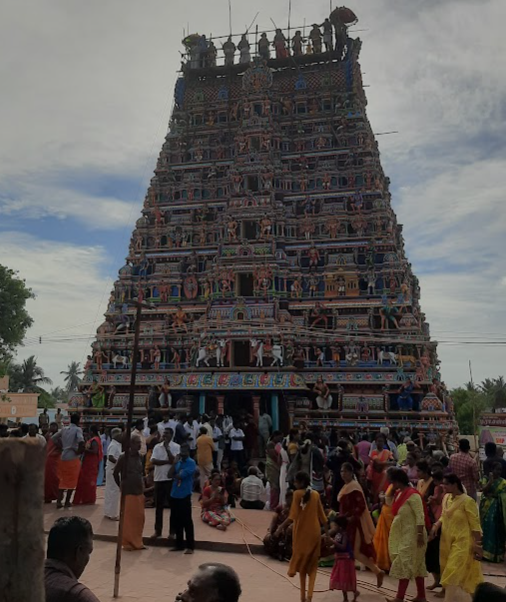According to legend, during a time of famine, Kamadhenu, the celestial cow, mistakenly consumed meat. Upon learning this, Lord Shiva cursed Kamadhenu to turn into a tiger. Filled with remorse, Kamadhenu sought forgiveness from Lord Shiva, who instructed her to go to Mallikaranyam (a jasmine forest on Earth), bathe there, and worship him to be freed from the curse. Following these instructions, Kamadhenu created a pond in this place, which became filled with milk. Over time, the milk turned into butter. Sage Vasishta, on Shiva's orders, came to this place, made a Lingam out of the butter, and worshipped it. Because of this, Lord Shiva here is known as Vennei Nadar (Lord of Butter). When attempts were made to move the butter Lingam, it would not budge, leading to the place being named Sikkal (meaning "problem" or "obstacle").
Sthala Puranam :
Once, Kamadhenu, the celestial cow, mistakenly consumed meat and was cursed to be born as a tiger on Earth. Filled with remorse, she worshipped Lord Shiva, who forgave her and instructed her to worship him at Mallikaranyam, an ancient jasmine forest, to lift the curse. Following his advice, Kamadhenu created a temple tank, Ksheera Pushkarini, which she filled with milk from her udder. Over time, the milk churned into butter. Sage Vasishta, in search of Kamadhenu, arrived at this place and crafted a Lingam from the butter. Hence, the Lord here is known as Navaneeteswarar or Vennai Nathar. When Vasishta attempted to move the butter Lingam, it became entangled with the surrounding jasmine plants, and thus the place was named Sikkal, meaning "tangled." Another version of the story says that the temple faced many obstacles during its construction, leading to the name "Sikkal," which also means "problem" or "difficulty."
According to legend, before Lord Vishnu took the Vamana Avatar to defeat the Asura king Mahabali, he worshipped Lord Shiva at this temple to seek his blessings. A separate shrine for Kola Vamana Perumal exists within the temple, and Anjaneyar is also present in a shrine facing Perumal. Sikkal is one of the 28 temples where both Lord Shiva and Lord Vishnu are enshrined together.
Sikkal is also renowned for its Murugan shrine, where he is worshipped as Singaravelar, holding his Vel (spear). The temple is famous for the legend of Murugan receiving his Vel from Parvati before his battle against Soorapadman at Tiruchendur. The annual SooraSamharam festival is celebrated with grandeur here, and it is said that during the Sashti festival, beads of sweat can be seen on the idol of Murugan when he receives the Vel. Arunagirinathar has praised Lord Murugan of Sikkal in his Thiruppugazh hymns.
The Murugan idols at Sikkal, Ettukudi, and Enkan share a deep connection. According to legend, the same sculptor crafted all three statues. After completing the Sikkal idol, the sculptor was so mesmerised that he vowed never to make another like it and cut off his right thumb. However, after a divine dream, he created the Murugan idol at Ettukudi, even though he was blind. With his daughter’s help, he crafted a third idol at Enkan, and an accident during the process restored his vision. Some versions of the story say that the Chola King Mutharasan had the sculptor’s thumb cut off after the first statue, and later had him blinded, but eventually sought forgiveness for his actions after realising the sculptor’s greatness.
Administration History :
The temple was originally built by Ko Chengat Chozha as one of the Mada temples. It was later reconstructed as a stone temple during the Chozha period and extended by the Vijayanagara and Thanjavur Nayakas. Further renovations were undertaken by the Nattukottai Nagarathars, with Sri Alagappa Chettiar playing a significant role in the construction of the Rajagopuram and Kalyana Mandapam in 1932. His son, Karumuthu Thyagaraja Chettiar, continued overseeing temple administration from 1944. The temple is now maintained by the HR&CE Department of Tamil Nadu.
